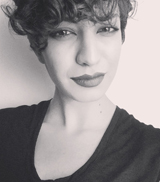Member of the Month
April 2020
 Haniyeh Mirdamadi, MIES
Haniyeh Mirdamadi, MIES
Lighting Designer, Arup
Q: How did you first get started in the lighting industry?
My official job title is Lighting Designer, but I’m a Lighting Designer and Habitability Researcher for Extreme Environments. My path to becoming a lighting designer and a specialist in this area, was not as inspiring as I’d like it to have been. It was another disparate reach after trying so many other careers and interests that had previously failed to satisfy me.
I studied graphic design at Tehran Azad University in Iran and received by master’s degree at the Architectural Lighting Design program at Parsons, The New School. My thesis, entitled “The Role of Light on the Psychological Effects of Long Duration Space Expeditions and Human Colonization of Mars,” was a topic that was definitely out of the ordinary, yet my thesis advisors, Craig Bernecker and Glenn Schrum, did not stop me from pursuing my interest. I always knew I wanted to do something that serves the greater good, that is powerful, but I wasn’t sure what that was. When I did get into the world of lighting design, I was absolutely stunned by the many aspects of light. It doesn’t only render the world around us; it emotionally, physically and psychologically affects humans. Oh wait, not only humans but almost every living being on this planet – or even beyond this planet! Even better, it interacts with shapes and materials in mysterious ways, our world, experiences and memories would be so plain and dull without them. That’s when I thought…what if the light we receive from the sun had no significant matter to interact with, if there was no atmosphere, if the color, intensity or doses of light and day/night rhythms were different? I studied the quality of human life in Antarctica, submarines, caves, prison solitary confinements, micro-housing, the International Space Station (ISS), and other celestial bodies. And so, I developed an interest in the visual and non-visual effects of light on human chronobiology and cognitive performance in extreme terrestrial and extra-terrestrial environments. I finally feel at home, knowing that I’ll never get to the end of the mysteries of light, and all it tells us about the universe.
I interviewed at Arup before graduating Parsons and ever since, I have received full support from Brian Stacy, principal, project director, and global lighting leader at Arup, to continue to pursue my passion and promote human well-being for extreme living conditions. My role involves advising clients on lighting design strategies in a wide variety of projects for terrestrial and extra-terrestrial applications. Along with her team, AI.SpaceFactory, she garnered second place on the design stage and first place in the finale of NASA Phase III, 3-D printed Habitat challenge in 2019, and first place with her team Mars Colony X, in the 2018 Mars City Design Competition.
Q: How did you first get involved in the IESNYC?
I was a student member of the IESNYC from 2015 to 2017 while attending Parsons and found the Section to be quite supportive of me and my fellow students.
Q: How do you see your role as member of the IESNYC?
Earlier this year, I was asked to speak about lighting design for extreme living conditions and off world habitation at the “Lighting for Difficult Environments” joint IES Houston and NASA mini conference held at NASA’s Johnson Space Center. Jared Gunlock from IES Houston had heard about my work reached out to the IESNYC to see if they would support me in order to make the trip to Houston. Member of the Board of Managers Phil Cialdella and president of Light Abilities, who I’ve worked with on projects, contacted me and said the Section would be happy to support me, but as it turned out, Arup gave me financial assistance I needed to attend. I am grateful to the Section for offering their assistance. That said, I would like to help advocate for those with unique visions and perspectives, and to encourage creativity and tolerance for alternative views and approaches in our industry.
Q: In your opinion, what are the best assets of the IESNYC?
Like New York City itself, the IESNYC is a very large and diverse community. It’s a great organization to connect, learn and share. I hope to be able to share my work with the members of the Section.
2025 IESNYC Event and Educational Sponsors
Brilliant Sponsors
Radiant Sponsors
Glow Sponsors
Sparkle Sponsor
Twinkle Sponsors
Available Light | Hartranft Lighting Design | HLB Lighting Design
